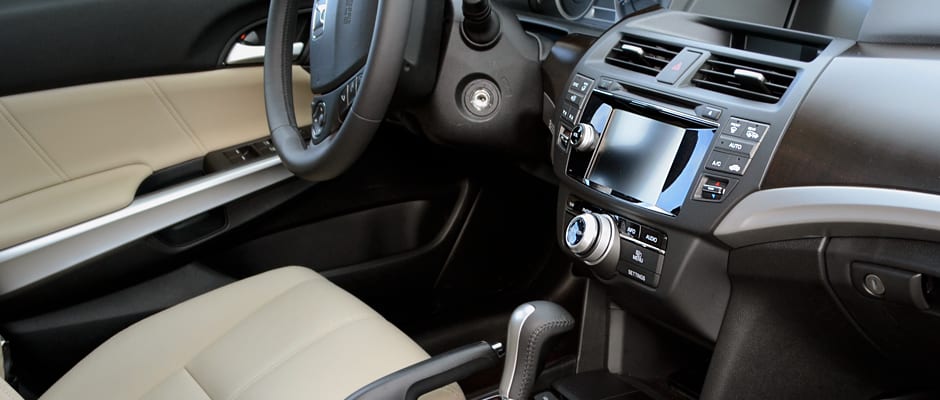Introduction
The Crosstour is an Accord with a backpack, and that's not a bad thing
That's why Honda decided to redesign the Crosstour for 2013, with a more aggressive front end that makes it look less like the Accord sedan. Other than the sheetmetal, however, the two cars are almost identical, and that's not a bad thing: We enjoyed driving the Accord, and found the Crosstour just as agreeable. Priced around $30,000, our tester seemed a great choice for active empty nesters or young families who don't want to go full-on crossover.
Lucky for potential Crosstour buyers out there, Honda has also included all the cool new tech that's on the new Accord: Lane departure warning, a side-view camera, and HondaLink – a smartphone connectivity suite featuring Harmon's Aha infotainment platform. Unfortunately, the Crosstour also features Honda's dual-screen i-MID, which struggles with the complexity of the car's infotainment offerings.
Tech & Entertainment
A weak interface sandbags some truly innovative tech
In theory, HondaLink and Aha impress us. Together, they use a phone's data connection to push selected parts of the wider internet right to the Crosstour's dashboard in an easy-to-digest form. Podcasts, streaming audio, Yelp reviews, Facebook, Twitter — they're all there, and they're all designed to be easily accessible for drivers and passengers. Want to listen to Wait, Wait, Don't Tell Me? on a Tuesday, or listen to KROQ even though you're in Maryland? Not a problem.
What is a problem is Honda's i-MID, which is short for Intelligent Multi-Information Display. The system uses two screens — a small, low-functioning touchscreen and a large LCD that's controlled by an over-jiggly jog wheel. That's confusing enough. What's worse is the multi-layered menus that often duplicate each others' functionality. For instance, we found three distinct ways of adjusting the volume of the navigation system's voice prompts. Combine a labyrinthine user interface with subpar voice recognition, and you have a system that frustrates users instead of facilitating connectivity.
There's also an aggravating bugginess to the whole setup. For example, Aha offers a very cool service that reads aloud the names of nearby coffee shops and restaurants, much like a friend in the passenger seat searching Yelp on a smartphone. Unlike any friend we've ever had, though, there's also a button you can press to navigate to an establishment that strikes your fancy. That button doesn't silence Aha, however, and it will continue to read off the names of restaurants while the navigation system simultaneously barks out its orders. Another issue: Aha will only read off Facebook and Twitter status updates from a BlackBerry or Android phone.
On the Crosstour, not all the tech is entertainment related. There's also a lane-departure warning alarm, plus an industry-first camera mounted on the side-view mirror. Turn on the LaneWatch system and the Crosstour's LCD screen will display a wide view of your passenger-side blind spot whenever you use your right turn signal. It's helpful for spotting cyclists in the city, though we'd like to see it as an option on both sides of the car for merging. A zoom option would help with parallel parking, too.
{{photo_gallery "tech"}}
Design
That bulbous hatch might not be everyone's cup of tea, but it's pretty practical.
When the Crosstour debuted, haters took to Honda's Facebook page to complain about the design. The company's response was lukewarm, saying the early renderings were "like a bad yearbook photo" and admitting that the styling "may not be for everyone." We weren't quite sure what to think of the Crosstour, but before we drove it we feared it would combine the practicality of a sedan with the nimbleness of an SUV.
The Crosstour, however, grew on us during the week we tested it. A trip to a furniture store didn't require us to pay for delivery, and all our camera crew's equipment fit in the back with plenty of room to spare. The wheel wells do intrude quite a bit when it comes to cargo capacity, however, so don't expect to have a flat floor for loading even when the seats are down. When they're up, there's plenty of legroom and enough cargo space to fit luggage for a weekend getaway.
{{photo_gallery "design"}}
Driving Experience
Not surprisingly, the Crosstour drives a lot like an Accord.
The odds were stacked against our tester: It was an EX-L variant, with the base four-cylinder engine and two-wheel drive. We were testing it in the hills around Boston shortly after a snowstorm.
Remarkably, the Crosstour lived up to the challenges we threw at it. We hauled four passengers and their bags on uphill stretches of highway. We did quick merges and passing maneuvers while lugging around furniture. We drove in icy parking lots. The Crosstour never complained, and we found it to be quite a capable cruiser. That larger rear end adds about five inches and 365 pounds over an Accord, but we didn't find it any less maneuverable.
Sporting? Hardly, but the Crosstour's steering and suspension still remain communicative enough to keep drivers involved and alert. It doesn't jar you over bumps, but it doesn't feel like it's been lubricated in Anbesol, either. We think that's a perfect match for a car designed to be at home on long trips or stop-and-go traffic.
Conclusion
If you can get over its looks, the 2013 Honda Crosstour is a solid performer with some very innovative features.
For 2013, the Honda Crosstour's looks got a little less polarizing. If you still can't stand the shape, however, you may be won over by an interior chock full of technology to keep you safe and entertained. Regrettably, all of those advances are paired to a user interface that's less than user friendly.
Trim Levels
The Crosstour starts at $27,230 for a base model with front-wheel drive. Fully loaded, the all-wheel drive EX-L with a V6 and navigation tops out the range at $37,090.
In between, Honda continues their relatively straightforward method of options: Each trim level gets a set bunch of features, and there's nothing you can tack on afterward short of a navigation system. That means the 2WD EX V6 gets a V6 engine, front-wheel drive and cloth seats, the 2WD EX-L we drove got leather, navigation, front-wheel drive and a four-cylinder engine, and the 2WD EX-L V6 gets all those features plus a V6.
Powertrain
The Crosstour comes with your choice of a 192 hp four-cylinder engine and a five-speed automatic transmission or a 278 hp V6 and a six-speed automatic transmission. Cars equipped with the six-cylinder engine can get all-wheel drive in EX-L trim. The rest of them are front-wheel drive. There's no manual transmission option.
Safety
The National Highway Traffic Safety Administration hasn't rated the 2013 Crosstour except for rollover risk, where it gets four stars to indicate it has a low risk of rollover.
The Insurance Institute for Highway Safety ranks the 2013 Crosstour as a Top Safety Pick. It gets top "Good" ratings in the front, side, and roof strength tests. It has not been tested in IIHS's new small overlap test, which simulates hitting a pole with a small portion of the front of the car at a speed of 40 mph.
Fuel Economy
A Honda Crosstour with a four-cylinder engine, like the one we drove, is EPA rated at 22 mpg city and 31 mpg highway. We saw numbers closer to the low end of that range in our real-world testing. With front-wheel drive, cars equipped with the six-cylinder engine get 20 city, 29 highway. Cars equipped with all-wheel drive get 18 city, 28 highway.
Meet the tester
Keith was the Editor in Chief of Reviewed's appliance and automotive sites. His work has appeared in publications such as Wired, Car & Driver, and CityLab.
Checking our work.
Our team is here for one purpose: to help you buy the best stuff and love what you own. Our writers, editors, and lab technicians obsess over the products we cover to make sure you're confident and satisfied. Have a different opinion about something we recommend? Email us and we'll compare notes.
Shoot us an email


